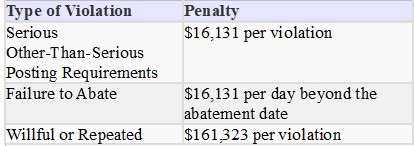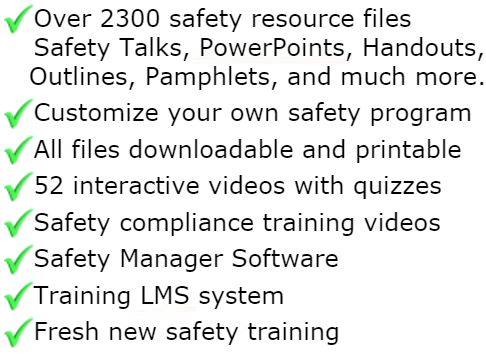
Permit Required Confined Space
Confined spaces can be categorized generally as those with open tops and with a depth that will restrict the natural movement of air, and enclosed spaces with very limited openings for entry. In either of these cases, the space may contain mechanical equipment with moving parts. Any combination of these parameters will change the nature of the hazards encountered.
Ventilation
Before forced ventilation is initiated, information such as restricted areas within the confined space, voids, the nature of the contaminants present, the size of the space, the type of work to be performed, and the number of people involved should be considered. The ventilation air should not create an additional hazard due to recirculation of contaminants, improper arrangement of the inlet duct, or by the substitution of anything other than fresh (normal) air (approximately 20.9% oxygen, 78.1% nitrogen, and 1% argon with small amounts of various other gases). The terms air and oxygen are sometimes considered synonymous. However, this is a dangerous assumption, since the use of oxygen in place of fresh (normal) air for ventilation will expand the limits of flammability and increase the hazards of fire and explosion.
Types of Confined Spaces
Confined spaces can be categorized generally as those with open tops and with a depth that will restrict the natural movement of air, and enclosed spaces with very limited openings for entry. In either of these cases, the space may contain mechanical equipment with moving parts. Any combination of these parameters will change the nature of the hazards encountered. Degreasers, pits, and certain types of storage tanks may be classified as open topped confined spaces that usually contain no moving parts. However, gases that are heavier than air (butane, propane, and other hydrocarbons) remain in depressions and will flow to low points where they are difficult to remove. Open topped water tanks that appear harmless may develop toxic atmospheres such as hydrogen sulfide from the vaporization of contaminated water. Therefore, these gases (heavier than air) are a primary concern when entry into such a confined space is being planned. Other hazards may develop due to the work performed in the confined space or because of corrosive residues that accelerate the decomposition of scaffolding supports and electrical components.
Confined spaces such as sewers, casings, tanks, silos, vaults, and compartments of ships usually have limited access. The problems arising in these areas are similar to those that occur in open topped confined spaces. However, the limited access increases the risk of injury. Gases which are heavier than air such as carbon dioxide and propane, may lie in a tank or vault for hours or even days after the containers have been opened. Because some gases are odorless, the hazard may be overlooked with fatal results. Gases that are lighter then air may also be trapped within an enclosed type confined space, especially those with access from the bottom or side.
Hazards specific to a confined space are dictated by: (1) the material stored or used in the confined space; as an example, damp activated carbon in a filtration tank will absorb oxygen, thus creating an oxygen deficient atmosphere; (2) the activity carried out, such as the fermentation of molasses that creates ethyl alcohol vapors and decreases the oxygen content of the atmosphere; or (3) the external environment, as in the case of sewer systems that may be affected by high tides, heavier than air gases, or flash floods.ce.
The most hazardous kind of confined space is the type that combines limited access and mechanical devices. All the hazards of open top and limited access confined spaces may be present together with the additional hazard of moving parts. Digesters and boilers usually contain power-driven equipment which, unless properly isolated, may be inadvertently activated after entry. Such equipment may also contain physical hazards that further complicate the work environment and the entry and exit process.
Reasons for Entering Confined Spaces
Entering a confined space as part of the industrial activity may be done for various reasons. It is done usually to perform a necessary function, such as inspection, repair, maintenance (cleaning or painting), or similar operations which would be an infrequent or irregular function of the total industrial activity.
Entry may also be made during new construction. Potential hazards should be easier to recognize during construction since the confined space has not been used. The types of hazards involved will be limited by the specific work practices. When the area meets the criteria for a confined space, all ventilation and other requirements should be enforced.
One of the most difficult entries to control is that of unauthorized entry, especially when there are large numbers of workers and trades involved, such as welders, painters, electricians, and safety monitors.
A final and most important reason for entry would be emergency rescue. This, and all other reasons for entry, must be well planned before initial entry is made and the hazards must be thoroughly reviewed. The standby person and all rescue personnel should be aware of the structural design of the space, emergency exit procedures, and life support systems required.
HAZARDOUS ATMOSPHERES
Hazardous atmospheres encountered in confined spaces can be divided into four distinct categories: Flammable, Toxic, Irritant and/or Corrosive, and Asphyxiating.
Flammable Atmospheres
A flammable atmosphere generally arises from enriched oxygen atmospheres, vaporization of flammable liquids, byproducts of work, chemical reactions, concentrations of combustible dusts, and desorption of chemical from inner surfaces of the confined space.
An atmosphere becomes flammable when the ratio of oxygen to combustible material in the air is neither too rich nor too lean for combustion to occur. Combustible gases or vapors will accumulate when there is inadequate ventilation in areas such as a confined space. Flammable gases such as acetylene, butane, propane, hydrogen, methane, natural or manufactured gases or vapors from liquid hydrocarbons can be trapped in confined spaces, and since many gases are heavier than air, they will seek lower levels as in pits, sewers, and various types of storage tanks and vessels. In a closed top tank, it should also be noted that lighter than air gases may rise and develop a flammable concentration if trapped above the opening.
The byproducts of work procedures can generate flammable or explosive conditions within a confined space. Specific kinds of work such as spray painting can result in the release of explosive gases or vapors. Welding in a confined space is a major cause of explosions in areas that contain combustible gas.
Chemical reactions forming flammable atmospheres occur when surfaces are initially exposed to the atmosphere, or when chemicals combine to form flammable gases. This condition arises when dilute sulfuric acid reacts with iron to form hydrogen or when calcium carbide makes contact with water to form acetylene. Other examples of spontaneous chemical reactions that may produce explosions from small amounts of unstable compounds are acetylene-metal compounds, peroxides, and nitrates. In a dry state, these compounds have the potential to explode upon percussion or exposure to increased temperature. Another class of chemical reactions that form flammable atmospheres arise from deposits of pyrophoric substances (carbon, ferrous oxide, ferrous sulfate, iron, etc.) that can be found in tanks used by the chemical and petroleum industry. These tanks containing flammable deposits will spontaneously ignite upon exposure to air.
Combustible dust concentrations are usually found during the process of loading, unloading, and conveying grain products, nitrated fertilizers, finely ground chemical products, and any other combustible material. High charges of static electricity, which rapidly accumulate during periods of relatively low humidity (below 50%), can cause certain substances to accumulate electrostatic charges of sufficient energy to produce sparks and ignite a flammable atmosphere. These sparks may also cause explosions when the right air or oxygen to dust or gas mixture is present.
Toxic Atmospheres
The substances to be regarded as toxic in a confined space can cover the entire spectrum of gases, vapors, and finely-divided airborne dust in industry. The sources of toxic atmospheres encountered may arise from the following:
1. The manufacturing process (for example, in producing polyvinyl chloride, hydrogen chloride is used as will as vinyl chloride monomer, which is carcinogenic).
2. The product stored [removing decomposed organic material from a tank can liberate toxic substances, such as hydrogen sulfide (H2S)].
3. The operation performed in the confined space (for example, welding or brazing with metals capable of producing toxic fumes).
During loading, unloading, formulation, and production, mechanical and/or human error may also produce toxic gases which are not part of the planned operation.
Carbon monoxide (CO) is a hazardous gas that may build up in a confined space. This odorless, colorless gas that has approximately the same density as air is formed from incomplete combustion of organic materials such as wood, coal, gas, oil, and gasoline; it can be formed from microbial decomposition of organic matter in sewers, silos, and fermentation tanks. Carbon monoxide is an insidious toxic gas because of its poor warning properties. Early stages of CO intoxication are nausea and headache. Carbon monoxide may be fatal at 1000 ppm in air, and is considered dangerous at 200 ppm, because it forms carboxyhemoglobin in the blood which prevents the distribution of oxygen in the body.
Carbon monoxide is a relatively abundant colorless, odorless gas, therefore, any untested atmosphere must be suspect. It must also be noted that a safe reading on a combustible gas indicator does not ensure that CO is not present. Carbon monoxide must be tested for specifically. The formation of CO may result from chemical reactions or work activities, therefore fatalities due to CO poisoning are not confined to any particular industry. There have been fatal accidents in sewage treatment plants due to decomposition products and lack of ventilation in confined spaces. Another area where CO results as a product of decomposition is in the formation of silo gas in grain storage elevators. In another area, the paint industry, varnish is manufactured by introducing the various ingredients into a kettle, and heating them in an inert atmosphere, usually town gas, which is a mixture of carbon dioxide and nitrogen.
In welding operations, oxides of nitrogen and ozone are gases of major toxicologic importance, and incomplete oxidation may occur and carbon monoxide can form as a byproduct.
Another poor work practice, which has led to fatalities, is the recirculation of diesel exhaust emissions. Increased CO levels can be prevented by strict control of the ventilation and the use of catalytic convertors..
Irritant (Corrosive) Atmospheres
Irritant or corrosive atmospheres can be divided into primary and secondary groups. The primary irritants exert no systemic toxic effects (effects on the entire body). Examples of primary irritants are chlorine, ozone, hydrochloric acid, hydrofluoric acid, sulfuric acid, nitrogen dioxide, ammonia, and sulfur dioxide. A secondary irritant is one that may produce systemic toxic effects in addition to surface irritation. Examples of secondary irritants include benzene, carbon tetrachloride, ethyl chloride, trichloroethane, trichloroethylene, and chloropropene.
Irritant gases vary widely among all areas of industrial activity. They can be found in plastics plants, chemical plants, the petroleum industry, tanneries, refrigeration industries, paint manufacturing, and mining operations.
Prolonged exposure at irritant or corrosive concentrations in a confined space may produce little or no evidence of irritation. This may result in a general weakening of the defense reflexes from changes in sensitivity. The danger in this situation is that the worker is usually not aware of any increase in his/her exposure to toxic substances.
Asphyxiating Atmospheres
The normal atmosphere is composed approximately of 20.9% oxygen and 78.1% nitrogen, and 1% argon with small amounts of various other gases. Reduction of oxygen in a confined space may be the result of either consumption or displacement.
The consumption of oxygen takes place during combustion of flammable substances, as in welding, heating, cutting, and brazing. A more subtle consumption of oxygen occurs during bacterial action, as in the fermentation process. Oxygen may also be consumed during chemical reactions as in the formation of rust on the exposed surface of the confined space (iron oxide). The number of people working in a confined space and the amount of their physical activity will also influence the oxygen consumption rate.
A second factor in oxygen deficiency is displacement by another gas. Examples of gases that are used to displace air, and therefore reduce the oxygen level are helium, argon, and nitrogen. Carbon dioxide may also be used to displace air and can occur naturally in sewers, storage bins, wells, tunnels, wine vats, and grain elevators. Aside from the natural development of these gases, or their use in the chemical process, certain gases are also used as inerting agents to displace flammable substances and retard pyrophoric reactions. Gases such as nitrogen, argon, helium, and carbon dioxide, are frequently referred to as non-toxic inert gases but have claimed many lives. The use of nitrogen to inert a confined space has claimed more lives than carbon dioxide. The total displacement of oxygen by nitrogen will cause immediate collapse and death. Carbon dioxide and argon, with specific gravities greater than air, may lie in a tank or manhole for hours or days after opening. Since these gases are colorless and odorless, they pose an immediate hazard to health unless appropriate oxygen measurements and ventilation are adequately carried out.
Oxygen deprivation is one form of asphyxiation. While it is desirable to maintain the atmospheric oxygen level at 21% by volume, the body can tolerate deviation from this ideal. When the oxygen level falls to 17%, the first sign of hypoxia is a deterioration to night vision which is not noticeable until a normal oxygen concentration is restored. Physiologic effects are increased breathing volume and accelerated heartbeat. Between 14-16% physiologic effects are increased breathing volume, accelerated heartbeat, very poor muscular coordination, rapid fatigue, and intermittent respiration. Between 6-10% the effects are nausea, vomiting, inability to perform, and unconsciousness. Less than 6%, spasmatic breathing, convulsive movements, and death in minutes.
GENERAL SAFETY HAZARDS
Mechanical
If activation of electrical or mechanical equipment would cause injury, each piece of equipment should be manually isolated to prevent inadvertent activation before workers enter or while they work in a confined space. The interplay of hazards associated with a confined space, such as the potential of flammable vapors or gases being present, and the build-up of static charge due to mechanical cleaning, such as abrasive blasting, all influence the precautions which must be taken.
To prevent vapor leaks, flashbacks, and other hazards, workers should completely isolate the space. To completely isolate a confined space, the closing of valves is not sufficient. All pipes must be physically disconnected or isolation blanks bolted in place. Other special precautions must be taken in cases where flammable liquids or vapors may re-contaminate the confined space. The pipes blanked or disconnected should be inspected and tested for leakage to check the effectiveness of the procedure. Other areas of concern are steam valves, pressure lines, and chemical transfer pipes. A less apparent hazard is the space referred to as a void, such as double walled vessels, which must be given special consideration in blanking off and inerting.
Communication Problems
Communication between the worker inside and the standby person outside is of utmost importance. If the worker should suddenly feel distressed and not be able to summon help, an injury could become a fatality. Frequently, the body positions that are assumed in a confined space make it difficult for the standby person to detect an unconscious worker. When visual monitoring of the worker is not possible because of the design of the confined space or location of the entry hatch, a voice or alarm-activated explosion proof type of communication system will be necessary.
Suitable illumination of an approved type is required to provide sufficient visibility for work in accordance with the recommendations made in the Illuminating Engineering Society Lighting Handbook.
Entry and Exit
Entry and exit time is of major significance as a physical limitation and is directly related to the potential hazard of the confined space. The extent of precautions taken and the standby equipment needed to maintain a safe work area will be determined by the means of access and rescue. The following should be considered: type of confined space to be entered, access to the entrance, number and size of openings, barriers within the space, the occupancy load, and the time requirement for exiting in event of fire or vapor incursion, and the time required to rescue injured workers.
Physical Hazards
Thermal Effects
Four factors influence the interchange of heat between people and their environment. They are: (1) air temperature, (2) air velocity, (3) moisture contained in the air, and (4) radiant heat. Because of the nature and design of most confined spaces, moisture content and radiant heat are difficult to control. As the body temperature rises progressively, workers will continue to function until the body temperature reaches approximately 102oF. When this body temperature is exceeded, the workers are less efficient, and are prone to heat exhaustion, heat cramps, or heat stroke. In a cold environment, certain physiologic mechanisms come into play, which tend to limit heat loss and increase heat production. The most severe strain in cold conditions is chilling of the extremities so that activity is restricted. Special precautions must be taken in cold environments to prevent frostbite, trench foot, and general hypothermia.
Protective insulated clothing for both hot and cold environments will add additional bulk to the worker and must be considered in allowing for movement in the confined space and exit time. Therefore, air temperature of the environment becomes an important consideration when evaluating working conditions in confined spaces.
Noise
Noise problems are usually intensified in confined spaces because the interior tends to cause sound to reverberate and thus expose the worker to higher sound levels than those found in an open environment. This intensified noise increases the risk of hearing damage to workers which could result in temporary or permanent loss of hearing. Noise in a confined space which may not be intense enough to cause hearing damage may still disrupt verbal communication with the emergency standby person on the exterior of the confined space. If the workers inside are not able to hear commands or danger signals due to excessive noise, the probability of severe accidents can increase.
Vibration
Whole body vibration may affect multiple body parts and organs depending upon the vibration characteristics. Segmental vibration, unlike whole body vibration, appears to be more localized in creating injury to the fingers and hands of workers using tools, such as pneumatic hammers, rotary grinders or other hand tools which cause vibration.
General Physical Hazards
Some physical hazards cannot be eliminated because of the nature of the confined space or the work to be performed. These hazards include such items as scaffolding, surface residues, and structural hazards. The use of scaffolding in confined spaces has contributed to many accidents caused by workers or materials falling, improper use of guard rails, and lack of maintenance to insure worker safety. The choice of material used for scaffolding depends upon the type of work to be performed, the calculated weight to be supported, the surface on which the scaffolding is placed, and the substance previously stored in the confined space.
Surface residues in confined spaces can increase the already hazardous conditions of electrical shock, reaction of incompatible materials, liberation of toxic substances, and bodily injury due to slips and falls. Without protective clothing, additional hazards to health may arise due to surface residues.
Structural hazards within a confined space such as baffles in horizontal tanks, trays in vertical towers, bends in tunnels, overhead structural members, or scaffolding installed for maintenance constitute physical hazards, which are exacerbated by the physical surroundings. In dealing with structural hazards, workers must review and enforce safety precautions to assure safety.
Rescue procedures may require withdrawal of an injured or unconscious person. Careful planning must be given to the relationship between the internal structure, the exit opening, and the worker. If the worker is above the opening, the system must include a rescue arrangement operated from outside the confined space, if possible, by which the employee can be lowered and removed without injury.
All materials in the members area for this topic index

GET INSTANT ACCESS
to THE MEMBERS LIBRARY
Safety materials created by safety professionals.
Access to the Safety Manager software.
Wide variety of safety videos and courses.
**Brand New** Safety Training Management System
Pre-Made Safety Materials Ready For Use
Created by experienced safety professionals & risk consultants. Saving you time, money, and risk of injuries.
95% of the work already done.
Below are the maximum penalty amounts, with the annual adjustment for inflation, that may be assessed after Jan. 15, 2024. (See OSHA Memo, Jan. 8, 2024).

**New OSHA HEAT 90 DAY**
>>Download Free HERE<<
**New 2024 OSHA 300 Form**
>>Download Free HERE<<
**Brand New**
Free with full membership subscription
Training LMS System
Ask The Safety Consultant
Safety Equipment Deal Finder

“SafetyInfo.com is the first go-to website for safety professionals and companies to use in establishing a solid safety program"
-Mike McKenzie, Certified Safety & Health Manager (CSHM), McSafety Solutions™
Note: You must have a full subscription to the Safety Library in order to use this material. Any use outside of your organization, for resell, or without an active membership is strictly prohibited and may result in prosecution under copyright infringement laws. Please contact us first, if you would be interested in reselling or using our materials for reproduction.
Inside the Members Library
Topic Index
Accident Prevention
Air Quality
Asbestos
Bloodborne Pathogens
Boilers
Chemical Safety
Compressed Gas
Confined Space
Construction
Construction Worksite
Cranes & Slings
Driver / Fleet Safety
Drug Free Workplace
Electrical
Emergency Management
Engineering Safety
Environmental
Equipment
Ergonomics
Fall Protection
Fire Safety & Prevention
First Aid
Flammable Materials
Forklifts
Hazard Communication
Hazardous Materials
Hearing Protection
Heat Stress
Hot Work
Housekeeping
Job Safety Analysis
Laboratory
Ladders
Lead
Lockout-Tagout
Machinery & Equipment
Material Handling
MSDS (SDS)
Medical & First Aid
Occupational Health
Office Safety
Off the Job Safety
Personal Protection
Process Safety
Record Keeping
Respiratory Protection
Silica Safety
Rules & Policies
Signs & Labels
Slips, Trips & Fall
Training
Terrorism Programs
Tool Safety
Vehicle & Driver
Violence Programs
Welding & Hot Work
Training Videos
Library Index
Training Materials
Videos/Courses
Talks
Articles
PowerPoint
Handouts
Training Overheads
Quizzes
Supervisor Briefs
Management Briefs
Safety Sessions
2 Minute OSHA Safety Talks
Pamphlets
First Aid Training
Supervisor Training
Hazardous Materials
Bomb Threat
Crossword Puzzles
Biological Agents
Forms & Documents
Forms
Checklists
Audit Guides
Inspections Guides
Signs & Labels
Environmental Audit Guides
Recordkeeping - OSHA 300
Sign & Label Maker
Safety Management Resources
Safety Manuals/Written Programs
Ergonomic Programs
Emergency Plans
Process Safety Management
Construction Safety
Occupational Health
Environmental
Topic Sheets
DOT Fleet-Driver
Hazardous Materials
Chemical Safety
Drug Free Workplace
Terrorism Programs
Development Guides
Safety Manager Software
Safety References & Graphics
Technical Safety Information
Posters
Topic & Fact Sheets
Development Information
Job Specific Safety Rules
Terrorism
Calculators
Safety Comic Strips
New Safety Training System
Schedule and train your employees with our materials. Add unlimited amount of employees. Record all progress and issue certificates. For group and individual training sessions.

